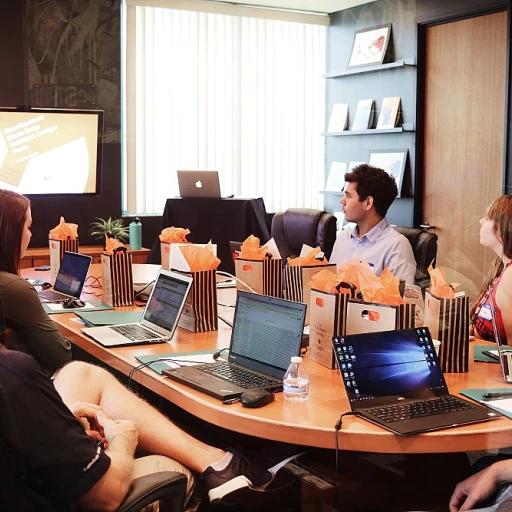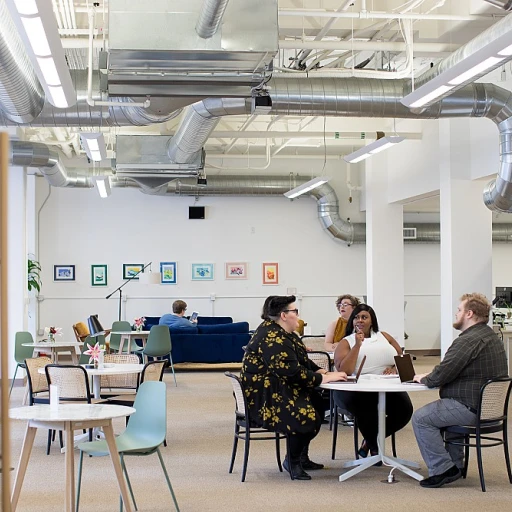
Understanding the Chief Impact Officer Role
Defining the Role and Responsibilities
The evolving workplace landscape has given rise to a myriad of transformative roles, one of the most noteworthy being that of the Chief Impact Officer (CIO). Positioned to navigate the intricate matrix of corporate responsibility and strategy, the CIO influences both internal operations and external relations.
At its core, this role revolves around steering the organization towards sustainable development and long-term social impact. In a strategic position, the officer acts as a bridge between the executive director and the wider community, lending focus to the organization’s social responsibility objectives.
Strategic Importance and Influence
Undoubtedly, the Chief Impact Officer occupies a pivotal position within the executive team. Charged with formulating an impact strategy, they ensure that goals align with the organization’s mission and values. This strategic planning entails leveraging experience and skills to foster collaboration across teams, ultimately amplifying the organization’s social impact.
The role is particularly vital in the United States, where social and environmental criteria significantly influence business outcomes. The ability to work harmoniously within cross-functional teams is augmented by strategic thinking and adeptness in social media engagement, which further drive the organization’s mission.
Expanding the Social and Digital Landscape
Integral to the role is the capacity to harness digital tools and platforms. The integration of artificial intelligence, for example, can revolutionize traditional frameworks for impact assessment, allowing for real-time analytics and precise strategic adjustments. As technology evolves, so must the approach of impact officers, ensuring that they remain ahead of the curve in communicating and effectuating positive change.
Ultimately, the Chief Impact Officer plays an essential role in shaping the future workforce, paving the way for high potential employees. By fostering a culture of innovation and accountability, the CIO facilitates a nurturing environment where leadership skills are honed and strategic visions are realized. Learn more about mastering leadership skills for high potential employees here.
Identifying High Potential Employees
Spotting Tomorrow's Leaders
In every organization, identifying high potential employees is crucial for long-term success. These are individuals who not only excel in their current role but also possess the capability to take on greater responsibilities in the future. A Chief Impact Officer (CIO) plays an essential role in this identification process, often using effective language to help describe the leadership qualities necessary for high potential individuals.
High potential employees typically exhibit a set of characteristics that distinguish them from their peers. Here are some key traits to watch for:
- Strategic Thinking: Ability to see the big picture and align their work with the organization's strategic goals.
- Social Responsibility: Consistent demonstration of social impact awareness within and outside the workplace.
- Adaptability: Comfort in navigating the evolving business landscape, especially with digital and artificial intelligence advancements.
- Community Engagement: Actively engaging with community and team members, fostering a culture of collaboration and support.
- Resilience: Capacity to handle challenges and setbacks while maintaining motivation and enthusiasm.
A CIO, along with other leadership roles such as an executive director or CEO, often leverages tools and frameworks for strategic planning in identifying these future leaders. For example, assessments and development programs tailored to align personal skills with organizational needs are critical.
The Role of Impact Officers in Recognizing Potential
Social impact officers also have a hand in spotting potential by understanding organizational needs and aligning them with team member abilities. These officers emphasize sustainable development and the external relations necessary for the overall growth of high potential employees.
Ultimately, identifying these individuals is not just about recognizing current skills but also about forecasting their potential to excel. This recognition process, spearheaded by impact officers, plays a significant role in shaping the future of the organization. In this ever-changing work environment, the ability to spot and nurture talent is a valuable asset that positions an organization for long-term strategic growth.
Strategies for Developing High Potential Employees
Effective Approaches to Nurturing Future Leaders
Developing high potential employees requires a well-structured approach that aligns with the organization's strategic goals. This section offers insights into leveraging both traditional and innovative methods to cultivate the skills and experience necessary for future leadership roles. Firstly, setting a solid foundation through comprehensive training programs is essential. These programs should not only focus on enhancing technical skills but also on developing social and emotional intelligence, enabling employees to thrive in social impact environments. Offering opportunities to engage in sustainable development projects can enhance their capability to work effectively in diverse settings. Secondly, mentorship and coaching are powerful tools that can significantly boost employee growth. Pairing high potential employees with seasoned executives, like a chief impact officer or an executive director, can provide these rising stars with valuable insights into strategic planning and impact strategies. These relationships often extend beyond the office, contributing to long-term professional and personal development. Incorporating digital tools and platforms can also enhance the development process. Leveraging exploring platforms similar to Award Co can facilitate recognition and reward systems, creating motivation and a sense of accomplishment among team members. Furthermore, the integration of artificial intelligence in assessing progress ensures that the development programs are tailored to meet individual and organizational needs. Finally, fostering a culture of open communication and feedback is crucial. The position of impact officers and other leadership roles relies heavily on the ability to adapt and respond to both internal and external relations. Encouraging dialogue within the community can bridge gaps and ensure that development aligns with both current and future organizational objectives, including social responsibility goals. By strategically nurturing employee talent, organizations can drive sustainable growth and innovation.Challenges Faced by High Potential Employees
Navigating the Challenges Faced by High Potential Employees
High potential employees (HiPos) are often seen as the lifeblood of an organization, expected to drive innovation, strategic growth, and sustain social impact. However, the path to success is not without its hurdles. Understanding the challenges these individuals face is crucial in supporting their journey.- Pressure of Expectations: The term "high potential" itself entails a significant burden of expectations. These employees are anticipated to deliver exceptional results consistently, contributing to the organization's strategic planning and development programs. The constant pressure can lead to stress and job dissatisfaction if not properly managed by leadership and the officer chief.
- Balancing External Relations and Internal Growth: HiPos are often thrust into roles that require interaction with external stakeholders, including partnerships and community work, under the direction of the CIO or executive director. Balancing these external relations with internal growth and development needs can be overwhelming.
- Navigating the Digital Landscape: With the rise of artificial intelligence and digital transformation, HiPos are expected to possess an enhanced skill set that encompasses both technical skills and social media acuity. This can be particularly challenging for those who may excel in one area but not the other.
- Adapting to Leadership Styles: The impact of leadership on employee potential cannot be understated. Employees must adapt to varying leadership styles within the office and in the larger organizational context. An adaptable HiPos must align with the impact strategy deployed by their chiefs or CEOs to maintain their trajectory.
- Social and Environmental Responsibility: HiPos are often positioned in initiatives that focus on sustainable development and social responsibility. While this experience can be enriching, it also adds another layer of complexity and responsibility to their roles, requiring them to juggle long-term strategic initiatives alongside immediate operational demands.
- Developing Resilience: As HiPos advance, building resilience becomes vital. The ability to work through setbacks and emerge stronger is crucial for maintaining long-term potential and ensuring they can continue contributing positively to their role within the organization.
The Impact of Leadership on Employee Potential
Influence of Effective Leadership on Employee Growth
In today's ever-evolving corporate landscape, leadership plays a crucial role in nurturing the potential of high-level talents within an organization. A strategic impact officer or chief executive officer has the responsibility of shaping the experience and growth of high potential employees.- The Role of Strategy in Leadership: Effective leaders develop comprehensive strategic plans that align with the organization's goals. These strategies include programs geared towards employee development, ensuring long-term growth. For instance, they may implement social responsibility initiatives that nurture sustainable development and social impact, providing employees with a platform to apply their skills.
- Leadership and External Relations: A savvy leader knows the importance of maintaining robust external relations, be it within the community or broader industry network. A chief impact officer, for instance, engages in digital and social media strategies to foster communication and collaboration. This position will integrate these external insights into internal programs, uplifting the team members' morale and potential.
- Influence of Strategic Planning: Leaders who excel in strategic planning can anticipate future trends and steer employee development in a direction that not only benefits the business but also enhances the professional growth of employees. By leveraging artificial intelligence tools and data insights, executives can create tailored development programs that meet the needs of both the individuals and the organization.
- Cultural and Social Environmental Impact: Being sensitive to the social and environmental aspects within the office, leaders set an example for high potential employees. They encourage a workplace culture that supports diversity, equity, and inclusivity, fostering an environment where employees feel valued and empowered to excel.
Future Trends in Employee Development
The Evolution of Employee Development
To stay relevant in this rapidly changing business environment, organizations need to adapt their employee development strategies. The digital wave, coupled with an increasing focus on sustainable development and social responsibility, demands that organizations rethink traditional approaches.- Digital Integration: Artificial intelligence is transforming how employee potential is assessed and developed. With AI-driven analytics, organizations can identify the skills and potential of employees more accurately, allowing for personalized development programs that cater to individual needs.
- Chief Impact Officer's Role: The impact officer in conjunction with the executive director, plays a crucial role in devising strategies that not only enhance employee potential but align with the organization's overarching social impact goals.
- Social Media Influence: Social media provides a platform for employees to develop their skills and showcase their abilities to a wider audience. Encouraging employees to actively participate in digital communities can foster a culture of learning and sharing, which is invaluable for personal and professional growth.
The Role of Strategic Planning
Strategic planning is pivotal in navigating future trends in employee development.- Social and Environmental Responsibility: More companies in the United States and globally are focusing on their social and environmental impact. This shift is reflected in their development programs, which now emphasize skills that contribute to achieving these goals.
- Building External Relations: Organizations focus on building strong external relations, enabling employees to engage with their broader communities and understand the impacts of their work.
- Impact Strategy: The CIO and other leaders ensure that the impact strategy aligns with the organization's long-term objectives. By doing so, they can better prepare high potential employees for future leadership roles, ensuring sustainability at both the organizational and community levels.












